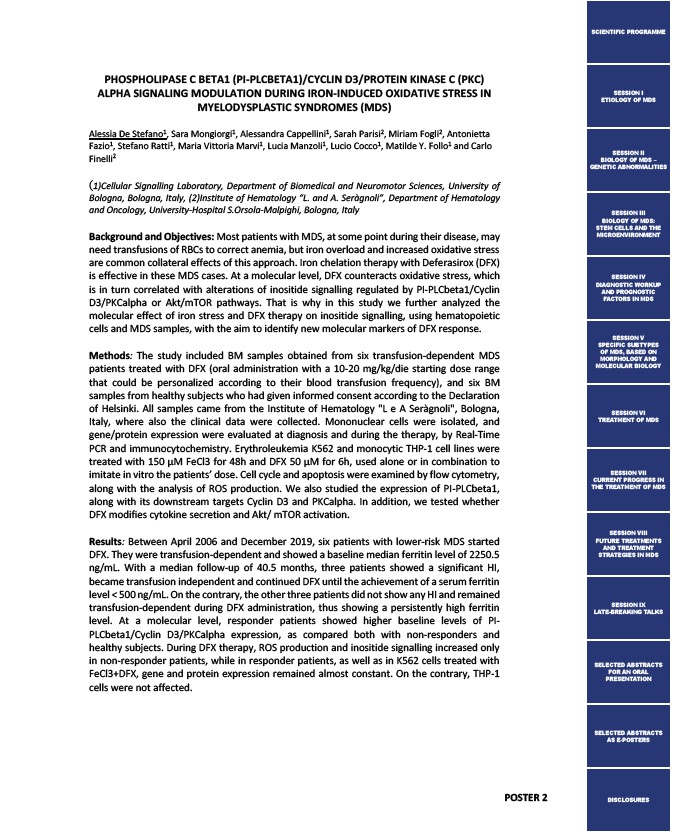
PHOSPHOLIPASE C BETA1 (PI-PLCBETA1)/CYCLIN D3/PROTEIN KINASE C (PKC)
ALPHA SIGNALING MODULATION DURING IRON-INDUCED OXIDATIVE STRESS IN
MYELODYSPLASTIC SYNDROMES (MDS)
Alessia De Stefano1, Sara Mongiorgi1, Alessandra Cappellini1, Sarah Parisi2, Miriam Fogli2, Antonietta
Fazio1, Stefano Ratti1, Maria Vittoria Marvi1, Lucia Manzoli1, Lucio Cocco1, Matilde Y. Follo1 and Carlo
Finelli2
(1)Cellular Signalling Laboratory, Department of Biomedical and Neuromotor Sciences, University of
Bologna, Bologna, Italy, (2)Institute of Hematology “L. and A. Seràgnoli”, Department of Hematology
and Oncology, University-Hospital S.Orsola-Malpighi, Bologna, Italy
Background and Objectives: Most patients with MDS, at some point during their disease, may
need transfusions of RBCs to correct anemia, but iron overload and increased oxidative stress
are common collateral effects of this approach. Iron chelation therapy with Deferasirox (DFX)
is effective in these MDS cases. At a molecular level, DFX counteracts oxidative stress, which
is in turn correlated with alterations of inositide signalling regulated by PI-PLCbeta1/Cyclin
D3/PKCalpha or Akt/mTOR pathways. That is why in this study we further analyzed the
molecular effect of iron stress and DFX therapy on inositide signalling, using hematopoietic
cells and MDS samples, with the aim to identify new molecular markers of DFX response.
Methods: The study included BM samples obtained from six transfusion-dependent MDS
patients treated with DFX (oral administration with a 10-20 mg/kg/die starting dose range
that could be personalized according to their blood transfusion frequency), and six BM
samples from healthy subjects who had given informed consent according to the Declaration
of Helsinki. All samples came from the Institute of Hematology "L e A Seràgnoli", Bologna,
Italy, where also the clinical data were collected. Mononuclear cells were isolated, and
gene/protein expression were evaluated at diagnosis and during the therapy, by Real-Time
PCR and immunocytochemistry. Erythroleukemia K562 and monocytic THP-1 cell lines were
treated with 150 μM FeCl3 for 48h and DFX 50 μM for 6h, used alone or in combination to
imitate in vitro the patients’ dose. Cell cycle and apoptosis were examined by flow cytometry,
along with the analysis of ROS production. We also studied the expression of PI-PLCbeta1,
along with its downstream targets Cyclin D3 and PKCalpha. In addition, we tested whether
DFX modifies cytokine secretion and Akt/ mTOR activation.
Results: Between April 2006 and December 2019, six patients with lower-risk MDS started
DFX. They were transfusion-dependent and showed a baseline median ferritin level of 2250.5
ng/mL. With a median follow-up of 40.5 months, three patients showed a significant HI,
became transfusion independent and continued DFX until the achievement of a serum ferritin
level < 500 ng/mL. On the contrary, the other three patients did not show any HI and remained
transfusion-dependent during DFX administration, thus showing a persistently high ferritin
level. At a molecular level, responder patients showed higher baseline levels of PI-PLCbeta1/
Cyclin D3/PKCalpha expression, as compared both with non-responders and
healthy subjects. During DFX therapy, ROS production and inositide signalling increased only
in non-responder patients, while in responder patients, as well as in K562 cells treated with
FeCl3+DFX, gene and protein expression remained almost constant. On the contrary, THP-1
cells were not affected.
POSTER 2
SCIENTIFIC PROGRAMME
SESSION I
ETIOLOGY OF MDS
SESSION II
BIOLOGY OF MDS –
GENETIC ABNORMALITIES
SESSION III
BIOLOGY OF MDS:
STEM CELLS AND THE
MICROENVIRONMENT
SESSION IV
DIAGNOSTIC WORKUP
AND PROGNOSTIC
FACTORS IN MDS
SESSION V
SPECIFIC SUBTYPES
OF MDS, BASED ON
MORPHOLOGY AND
MOLECULAR BIOLOGY
SESSION VI
TREATMENT OF MDS
SESSION VII
CURRENT PROGRESS IN
THE TREATMENT OF MDS
SESSION VIII
FUTURE TREATMENTS
AND TREATMENT
STRATEGIES IN MDS
SESSION IX
LATE-BREAKING TALKS
SELECTED ABSTRACTS
FOR AN ORAL
PRESENTATION
SELECTED ABSTRACTS
AS E-POSTERS
DISCLOSURES